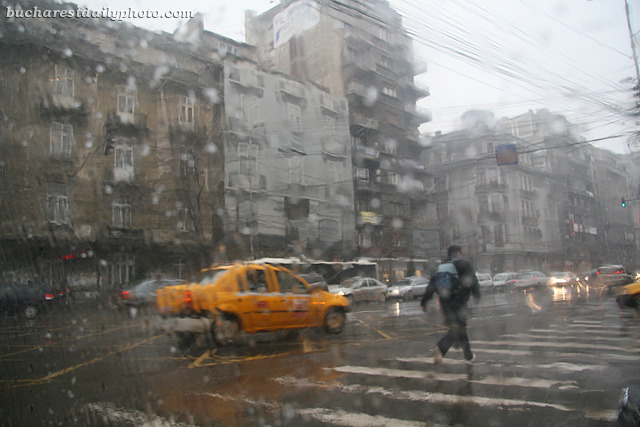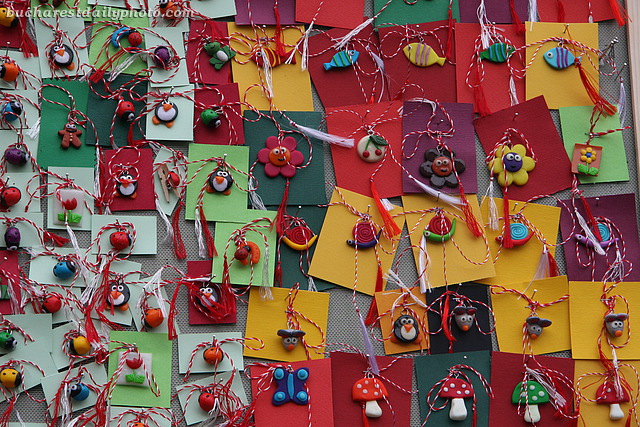I’ve talked before about Cişmigiu Park, one of my favorite places in Bucharest. It’s a lovely park where I always find something to photograph. In my previous posts about Cişmigiu – which can be found under the namesake tag – I’ve showed you some of its landmarks. Today I’m adding two more photos to this collection, both of the same statue, called The Black Woman ( “Negresa” in Romanian, bearing no offensive connotation). I’m guessing it is called like that because of its color, because the subject doesn’t really have the features of a black woman. In one of my books on Bucharest I’ve seen it called “The Nymph of the Lake” but I didn’t hear anyone using this name.
A Trabby painted with scary faces and the like, which looks not to have been taken out of its parking spot in a while.

After two weeks of somewhat warmer temperatures and a trace of the sun shining through, someone up there decided that the citizens of Bucharest have behaved badly and need to be punished. As if the grey sky and the rain weren’t enough, today we got ourselves a bit of sleet.
Let’s try a guessing game. Look at the photo above and try to guess where it was taken. You are very likely to have seen something similar, because according to wikipedia there’s 140 similar places around the world. The hints are: cocktails, American food, music and memorabilia. The walls should be a dead giveaway. Best place for nachos in Bucharest 🙂
Today’s photo was intended for yesterday, but since I decided to participate in the Theme Day of the City Daily Photo website, I kept it for today. Mărţisor is a traditional celebration taking place every year on March 1st and marking the arrival of spring. Its name comes from the name of the month of March (martie in Romanian) and literally it means “little” March. On this day the custom is to give small objects as a gift to those close to you, all this objects having one thing in common, a red and white string which is tied to the object. Usually men give this gifts to women and women (only) wear them pinned to their shirts for luck. The wikipedia article linked above cites that in the past this objects were seen as talismans or charms while today they have “became more of a symbol of friendship and love, appreciation and respect”. The article also talks about this custom being very old, with many ethnologists saying that its roots go as far as the Roman Empire or the Thracians. It is a nice custom and a good way for artists to make some money by selling hand made “mărtişoare” – the small object given as a gift bears the same name as the name of the celebration: mărţişor.
Today is Theme Day at the City Daily Photo community, a monthly event that happens the first day of every month, when all participating blogs will post a picture that relates to the theme day’s description. Today’s theme is: Passageway. Click here to view thumbnails for all participants
The covered English Passage is one of Bucharest’s historical passages linking Calea Victoriei with Academiei Street. It was built in 1885 and took its name from Hotel English which stood at one end of the passage, on Calea Victoriei. Some of the hotel rooms were located inside the passage. A few years later the hotel was converted into a luxury brothel (!), very famous at the times. The brothel lasted until 1947 when it was closed by the communists and the building was changed into apartments building. As you can see from the picture the passage is in really bad shape, even though I’ve read somewhere that it’s on the list of historical monuments. I hope the money to repair it will be found soon, before the passage is lost forever.
What do lions have to share with peacocks? It seems the answer is: the balcony of a house on Maria Rosetti Street.
The Victory Avenue (Calea Victoriei in Romanian) is one of Bucharest’s most important avenues. It was built as a main road in 1692 under orders from Constantin Brâncoveanu who needed a road to link his palace at Mogoşoaia with the Old Court. In the beginning the street was known as Podul Mogoşoaia aka Mogoşoaia Bridge, because it was paved with wood. In 1878, after the Romanian War of Independence, the victorious Romanian army entered the capital and marched along this avenue, and that’s when the name changed to Victory Avenue. Between the two world wars Calea Victoriei became one of the most fashionable streets of the capital. Following this avenue from United Nations Square (Piaţa Naţiunilor Unite in Romanian) to Victory Square (Piaţa Victoriei in Romanian) you’ll find some of the most beautiful buildings in Bucharest. Among these are the Naţional History Museum, the National Savings Bank or CEC building, the National Military Circle, Capşa House, the Art Deco Telephone Palace, the Creţulescu Church, the Central University Library, the Romanian Athenaeum, the Royal Palace which today houses the National Art Museum and the Cantacuzino Palace. I’ve already posted photos of some of these buildings on this blog and you can see them by following the “Victory Road” label. Today’s photo shows the classical facade of another beautiful building lining Calea Victoriei, Ştirbei Palace. It was built in 1833-1835 after plans by architect Michel Sanjouand.
Finally, a last shot (for a while) of the Athenaeum, all lit up and ready for the show.











